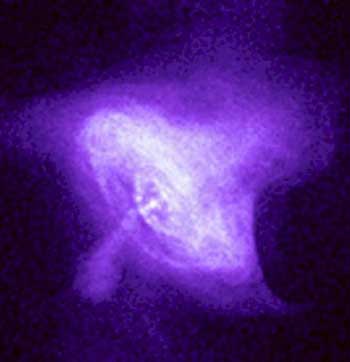Smallest Extrasolar Planet Found (Photo)
Astronomers from Penn State and Caltech have found the smallest extrasolar planet yet, orbiting a pulsar 1,500 light-years away. The small planet - the fourth discovered around this pulsar - has 1/5th the mass of Pluto, and orbits approximately the same distance as the asteroid belt orbits the Sun. The pulsar is spinning quickly, and gives off pulses of radiation at a very regular rate. Fluctuations in the pulses can then be used to calculate the orbits of planets going around them down to the size of large asteroids.

Penn State's Alex Wolszczan, the discoverer in 1992 of the first
planets ever found outside our solar system, now has discovered with Caltech's
Maciej Konacki the smallest planet yet detected, in that same far-away planetary
system. Immersed in an extended cloud of ionized gas, the new planet orbits a
rapidly spinning neutron star called a pulsar. The discovery, to be announced
during a press conference at a meeting concerning planetary formation and
detection in Aspen, Colorado, on 7 February, yields an astonishingly complete
description of the pulsar planetary system and confirms that it is remarkably
like a half-size version of our own solar system -- even though the star these
planets orbit is quite different from our Sun.
"Despite the extreme conditions that must have existed at the time these
planets were forming, Nature has managed to create a planetary system that looks
like a scaled-down copy of our own inner solar system," Wolszczan reports.
The star at the center of this system is a pulsar named PSR B1257+12 -- the
extremely dense and compact neutron star left over from a massive star that died
in a violent explosion 1,500 light years away in the constellation Virgo.
Wolszczan and his colleagues earlier had discovered three terrestrial planets
around the pulsar, with their orbits in an almost exact proportion to the
spacings between Mercury, Venus, and Earth. The newly discovered fourth planet
has an orbit approximately six times larger than that of the third planet in the
system, which Konacki says is amazingly close to the average distance from our
Sun to our solar system's asteroid belt, located between the orbits of Mars and
Jupiter.
"Because our observations practically rule out a possible presence of an
even more distant, massive planet or planets around the pulsar, it is quite
possible that the tiny fourth planet is the largest member of a cloud of
interplanetary debris at the outer edge of the pulsar's planetary system, a
remnant of the original protoplanetary disk that created the three inner
planets," Wolszczan explains. The small planet, about one-fifth of the mass
of Pluto, may occupy the same outer-boundary position in its planetary system as
Pluto does in our solar system. "Surprisingly, the planetary system around
this pulsar resembles our own solar system more than any extrasolar planetary
system discovered around a Sun-like star," Konacki says.
Fifteen years ago, before Wolszczan's discovery of the first extrasolar planets,
astronomers did not seriously entertain the idea that planets could survive
around pulsars because they would have been blasted with the unimaginable force
of the radiation and remnants of their exploding parent star. Since then,
Wolszczan, Konacki, and colleagues have gradually been unraveling the mysteries
of this system of pulsar planets, using the Arecibo radio telescope in Puerto
Rico to collect and analyze pulsar-timing data. "We feel now, with this
discovery, that the basic inventory of this planetary system has been
completed," Wolszczan says.
These discoveries have been possible because pulsars, especially those with the
fastest spin, behave like very accurate clocks. "The stability of the
repetition rate of the pulsar pulses compares favorably with the precision of
the best atomic clocks constructed by humans," Konacki explains.
Measurements of the pulse arrival times, called pulsar timing, give astronomers
an extremely precise method for studying the physics of pulsars and for
detecting the phenomena that occur in a pulsar's environment.
"A pulsar wobble due to orbiting planets manifests itself by variations in
the pulse arrival times, just like a stellar wobble is detectable with the
well-known Doppler effect so successfully used by optical astronomers to
identify planets around nearby stars by the shifts of their spectral
lines," Wolszczan explains. "An important advantage of the fantastic
stability of the pulsar clocks, which achieve precisions better than one
millionth of a second, is that this method allows us to detect planets with
masses all the way down to those of large asteroids."
The very existence of the pulsar planets may represent convincing evidence that
Earth-mass planets form just as easily as do the gas giants that are known to
exist around more than 5 percent of the nearby Sun-like stars. However,
Wolszczan says, "the message carried by the pulsar planets may equally well
be that the formation of Earth-like planets requires special conditions, making
such planets a rarity. For example, there is growing evidence that a nearby
supernova explosion may have played an important role in our solar system's
formation." Future space observatories, including the Kepler and the Space
Interferometry Missions, and the Terrestrial Planet Finder, will play a decisive
role in making a distinction between these fundamental alternatives.
Source: http://www.universetoday.com/am/publish/smallest_extrasolar_planet.html?822005